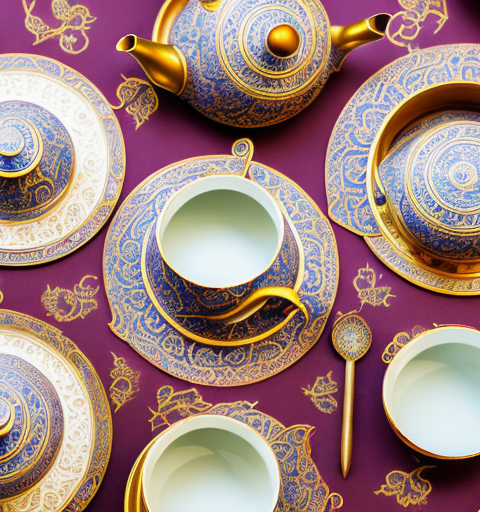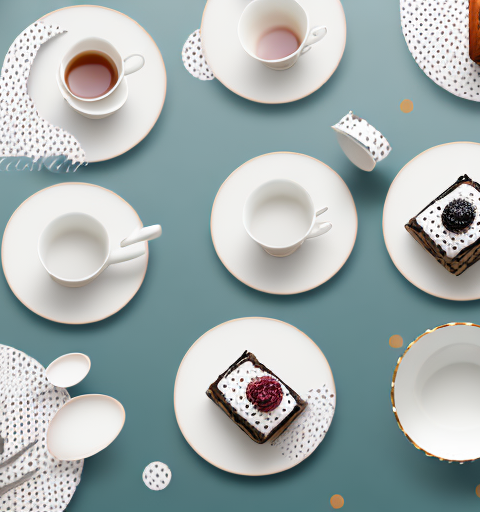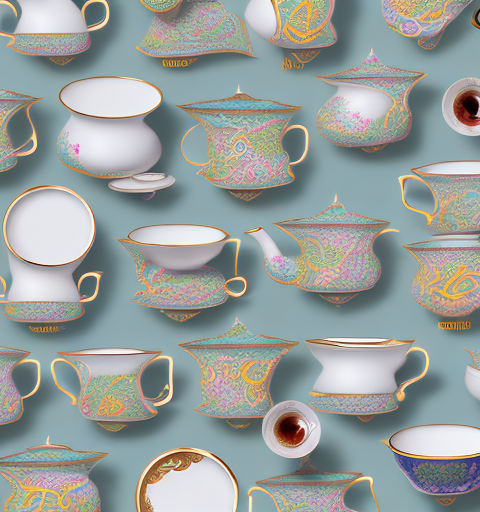Ceramic teapots have been a popular choice among tea enthusiasts for centuries. Their beauty, versatility, and ability to retain heat make them a favorite among many tea lovers. However, like any other material, ceramic teapots also come with their own set of disadvantages. In this article, we will explore these potential drawbacks in detail to help you make an informed decision when choosing a teapot for your tea brewing needs.
Introduction to ceramic teapots and their popularity
Ceramic teapots have a long-standing history and have been used for centuries in different cultures around the world. Their popularity lies in their aesthetic appeal, as ceramic teapots come in a wide range of designs, colors, and patterns, making them a beautiful addition to any tea set. Furthermore, ceramics have excellent heat retention properties, which allows the tea to stay hot for a longer period compared to other materials.
In addition to their aesthetic appeal and heat retention properties, ceramic teapots are also known for their durability. Unlike glass or porcelain teapots, ceramic teapots are less prone to breakage and can withstand high temperatures without cracking. This makes them a practical choice for everyday use and ensures that they can be enjoyed for years to come.
Another advantage of ceramic teapots is their versatility. They can be used with various types of tea, including black, green, herbal, and oolong. The porous nature of ceramic allows the tea to steep evenly, resulting in a flavorful and aromatic brew. Additionally, ceramic teapots do not retain flavors or odors, making it easy to switch between different types of tea without any lingering taste.
The benefits of using a ceramic teapot
Before diving into the disadvantages, let’s first explore the benefits of using a ceramic teapot. As mentioned earlier, one of the key advantages of ceramic teapots is their ability to retain heat. This ensures that your tea stays warm and enjoyable even after some time. Additionally, ceramic is an excellent insulator, preventing the exterior of the teapot from becoming too hot to handle.Ceramic teapots are also known for their versatility. They are suitable for brewing a variety of teas, including black, green, oolong, and herbal teas, allowing you to explore different flavors without having to switch teapots. Ceramic teapots also provide a smooth and consistent pour, ensuring a controlled and enjoyable tea-drinking experience.Another benefit worth mentioning is the aesthetic appeal of ceramic teapots. Whether you prefer a traditional or modern design, there is a vast array of ceramic teapots available to suit your personal style. These teapots can serve as a centerpiece during tea gatherings and enhance the overall ambience.
Furthermore, ceramic teapots are known for their durability. Unlike glass or porcelain teapots, ceramic teapots are less prone to breakage and can withstand daily use without losing their functionality or aesthetic appeal. This makes them a reliable and long-lasting choice for tea enthusiasts.
Exploring the potential downsides of ceramic teapots
While ceramic teapots have numerous advantages, it is important to consider the potential downsides before making a decision. One such disadvantage is their fragility and susceptibility to breakage. Ceramic teapots are more delicate compared to teapots made from materials such as cast iron or stainless steel. Extra care needs to be taken to prevent accidental drops or bumps that may lead to cracks or breakage.Another potential concern is the risk of chemicals leaching into your tea. Some low-quality ceramic teapots may contain lead or other harmful substances in their glaze. However, it is important to note that reputable manufacturers often use food-grade glazes that are safe for use. To ensure the safety of your tea, it is recommended to purchase ceramic teapots from trusted sources and verify that they meet safety standards.
Additionally, ceramic teapots may not retain heat as well as other materials. Due to their porous nature, ceramic teapots may lose heat faster, resulting in a shorter period of time in which your tea stays hot. This can be a drawback for those who prefer to savor their tea slowly or enjoy multiple cups over an extended period.
Furthermore, ceramic teapots may require more maintenance compared to other materials. Over time, the glaze on ceramic teapots may develop cracks or chips, which can affect their functionality and appearance. Regular inspection and proper cleaning are necessary to ensure the longevity of your ceramic teapot. It is also important to avoid using abrasive cleaning tools or harsh chemicals that may damage the glaze or alter the taste of your tea.
The impact of heat retention in ceramic teapots
While the ability of ceramic teapots to retain heat is considered a benefit, it can also be a potential disadvantage in certain situations. If you prefer to drink your tea slowly or enjoy multiple cups over an extended period, the prolonged heat retention of ceramic teapots may result in over-brewed or bitter tea. In such cases, it is advised to pour the remaining tea into a separate cup or utilize a tea cozy to help maintain the desired temperature.
On the other hand, the heat retention of ceramic teapots can be advantageous in certain scenarios. For example, if you are hosting a tea party or gathering where guests may want to enjoy multiple cups of tea at their own pace, the ceramic teapot’s ability to keep the tea hot for a longer period can be highly appreciated. This ensures that everyone can savor their tea without it getting cold too quickly. Additionally, the heat retention of ceramic teapots can be particularly beneficial during colder months, as it helps to keep the tea warm and comforting for a longer time.
Understanding the fragility and potential for breakage
As mentioned earlier, the delicate nature of ceramic teapots is worth considering. The risk of breakage is higher compared to teapots made from other materials such as stainless steel or glass. This fragility is especially important to keep in mind if you have young children or pets in your household. It is crucial to handle ceramic teapots with care and store them securely to minimize the risk of accidents.
One factor that contributes to the fragility of ceramic teapots is their composition. Ceramic teapots are typically made from clay that is fired at high temperatures to create a hardened, yet brittle, material. This makes them more susceptible to cracking or shattering if dropped or mishandled.
In addition to their composition, the design of ceramic teapots can also impact their fragility. Teapots with intricate or delicate handles, spouts, or lids may be more prone to breakage. These intricate details can create weak points in the structure of the teapot, making them more susceptible to damage.
Is there a risk of leaching chemicals into your tea?
The risk of chemicals leaching into your tea from ceramic teapots largely depends on the quality of the teapot’s glaze. As previously mentioned, reputable manufacturers use food-grade glazes that are safe for use. However, if you are unsure about the glaze composition of your teapot, it is best to err on the side of caution. Using a teapot with a stainless steel or glass interior may be a suitable alternative to mitigate any leaching concerns.
Another factor to consider is the temperature of the tea. Hot liquids can potentially accelerate the leaching process, so it is advisable to let your tea cool down slightly before pouring it into a ceramic teapot. This can help minimize the contact time between the tea and the glaze, reducing the risk of chemical leaching.
Furthermore, proper care and maintenance of your ceramic teapot can also play a role in minimizing the risk of chemical leaching. Avoid using abrasive cleaning materials or harsh chemicals that could potentially damage the glaze. Instead, opt for gentle cleaning methods such as using warm water and mild dish soap. Regularly inspect your teapot for any signs of wear or cracks in the glaze, as these can increase the likelihood of chemicals leaching into your tea.
Assessing the difficulty of cleaning ceramic teapots
One aspect that may be considered a disadvantage of ceramic teapots is the potential difficulty in cleaning them. Due to their porous nature, ceramic teapots tend to retain tea stains, which can be challenging to remove. Regular cleaning with warm water and mild soap may not be sufficient to eliminate stubborn stains. However, there are numerous methods available, including using baking soda or vinegar, that can help remove stains effectively. It is important to note that proper and regular cleaning is essential to maintain the hygiene and integrity of your ceramic teapot.
Additionally, it is recommended to avoid using abrasive cleaning tools, such as steel wool or harsh scrub brushes, as they can scratch the surface of the ceramic teapot. Instead, opt for soft sponges or brushes specifically designed for delicate surfaces. Furthermore, allowing the teapot to soak in a solution of warm water and dish soap for a few hours can help loosen stubborn stains before gently scrubbing them away. Remember to thoroughly rinse the teapot after cleaning to remove any residue and ensure a fresh taste for your next brew. Taking these extra steps in cleaning your ceramic teapot will help prolong its lifespan and maintain its aesthetic appeal.
Can ceramic teapots retain flavors and aromas?
Ceramic teapots have the ability to absorb and retain flavors and aromas. While this can be advantageous when brewing certain types of teas, it can be a disadvantage if you like to switch between different tea varieties. If not cleaned properly, the remnants of previous brews may affect the flavor profile of your current tea. To avoid this, it is recommended to dedicate specific teapots for different tea types or invest in a tea infuser that can be removed after brewing.
Additionally, the material of the ceramic teapot can also impact the retention of flavors and aromas. Porous ceramics, such as unglazed clay or earthenware, have a higher tendency to absorb and retain flavors compared to glazed ceramics. This is because the glaze creates a protective barrier that prevents the tea from seeping into the porous surface. Therefore, if you prefer a teapot that imparts a subtle flavor to your tea over time, opting for a porous ceramic teapot may be a suitable choice. However, if you prefer a neutral taste and easy cleaning, a glazed ceramic teapot would be more appropriate.
Comparing ceramic teapots to other material options
When considering the disadvantages of ceramic teapots, it is essential to compare them to teapots made from other materials. Stainless steel teapots, for example, are known for their durability and resistance to breakage. They are relatively easy to clean and do not retain flavors or aromas. However, they may not have the same aesthetic appeal as ceramic teapots. Ultimately, the choice between materials depends on your personal preferences and priorities.
Tips for prolonging the lifespan of a ceramic teapot
To maximize the lifespan of your ceramic teapot and reduce the likelihood of breakage, it is important to follow a few essential tips. Firstly, handle your teapot with care and avoid placing it in places where it may get knocked over. Secondly, store your teapot in a safe location where it is protected from any accidental damage. Lastly, clean your teapot regularly and carefully to maintain its integrity and prevent tea stains from becoming a long-term issue.
Are there any health concerns associated with using ceramic teapots?
When it comes to health concerns, it is important to reiterate that high-quality ceramic teapots made with food-grade glazes are safe for use. However, if you have specific health conditions or concerns, it is recommended to consult with a healthcare professional before using a ceramic teapot. They will be able to provide you with personalized guidance based on your individual circumstances.
Exploring alternative materials for teapots and their drawbacks
While ceramic teapots have their own set of disadvantages, it is worth exploring alternative materials to consider their drawbacks as well. Stainless steel teapots, for example, may not offer the same aesthetic appeal as ceramic teapots. Glass teapots, on the other hand, may be more prone to breakage. By understanding the potential downsides of different materials, you can make an informed decision based on your priorities and preferences.
Examining the cost-effectiveness of ceramic teapots
Cost-effectiveness is an aspect that may vary depending on individual circumstances. Ceramic teapots are available in various price ranges, catering to different budgets. Additionally, considering the longevity and durability of ceramic teapots when handled with care, they can be a long-term investment, offering value for money. It is important to strike a balance between your budget and the quality you desire when choosing a ceramic teapot.
The aesthetic appeal of ceramic teapots and their impact on tea-drinking experience
One of the most notable advantages of ceramic teapots is their aesthetic appeal and the impact they can have on the overall tea-drinking experience. The beauty and elegance of ceramic teapots can enhance the pleasure of your tea ritual and create a soothing and enjoyable ambiance. The choice of a teapot that visually resonates with you can elevate the entire tea-drinking experience and make it a truly memorable occasion.
How to select the right size and shape for your ceramic teapot
Choosing the right size and shape for your ceramic teapot largely depends on your personal preferences and requirements. If you prefer to brew tea for one or two people, a smaller teapot may be more suitable. However, if you often entertain guests or have a larger household, a larger teapot may be necessary. The shape of the teapot can also affect the pouring experience and the way the tea leaves infuse. It is beneficial to consider the functionality and aesthetics when selecting the size and shape of your ceramic teapot.
Eco-friendly aspects of using a ceramic teapot
From an eco-friendly perspective, ceramic teapots have several advantages. Unlike disposable paper teabags, ceramic teapots are reusable and reduce waste. Additionally, ceramic is a natural material that does not emit harmful substances when used. By opting for a ceramic teapot, you can contribute to a more sustainable and environmentally-friendly tea-drinking experience.
Analyzing customer reviews and experiences with ceramic teapots
It is always beneficial to analyze customer reviews and experiences before making a purchase decision. Reading the feedback and opinions of others who have used ceramic teapots can provide valuable insights into the advantages and disadvantages of different models and brands. Look for reviews that discuss the specific aspects, such as durability, heat retention, and ease of cleaning, that are important to you. Their experiences can help guide you in finding the right ceramic teapot that suits your needs.
Expert opinions on the disadvantages of using a ceramic teapot
Experts in the field of tea and teaware can offer valuable insights into the disadvantages of using a ceramic teapot. They may have conducted their own studies or experiments to assess the potential drawbacks of ceramic teapots. Consulting with experts or referencing their opinions can help you make a more informed decision based on knowledge and expertise.
Conclusion: weighing the pros and cons of using a ceramic teapot
In conclusion, ceramic teapots are a popular choice among tea enthusiasts due to their beauty, heat retention properties, and versatility. While they have numerous advantages, it is essential to consider the potential disadvantages before making a decision. The fragility and risk of breakage, the potential leaching of chemicals, and the difficulty of cleaning may be important factors to contemplate. However, with proper care and attention, these drawbacks can be effectively managed. Ultimately, the choice of using a ceramic teapot depends on individual preferences, priorities, and requirements.






